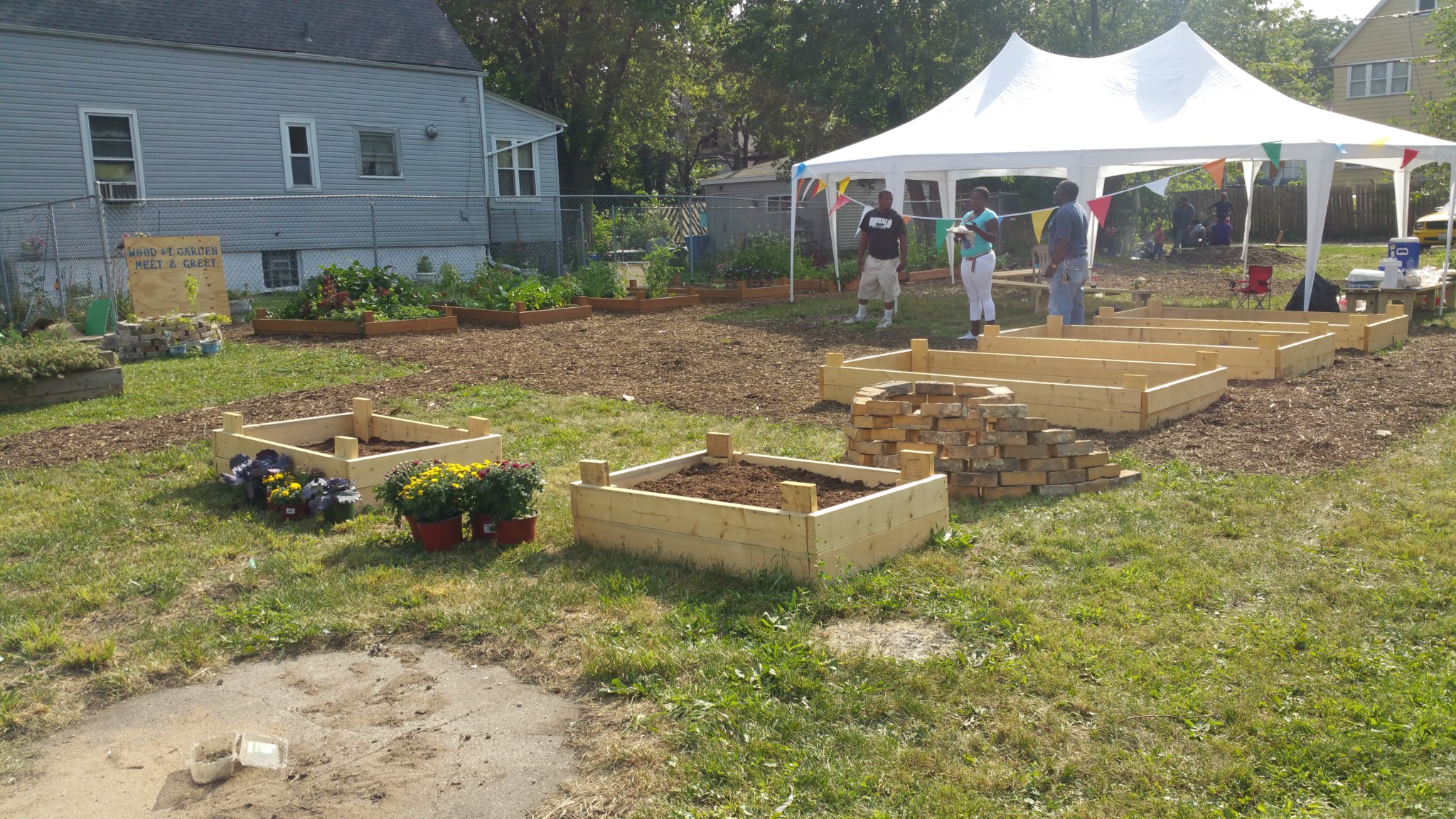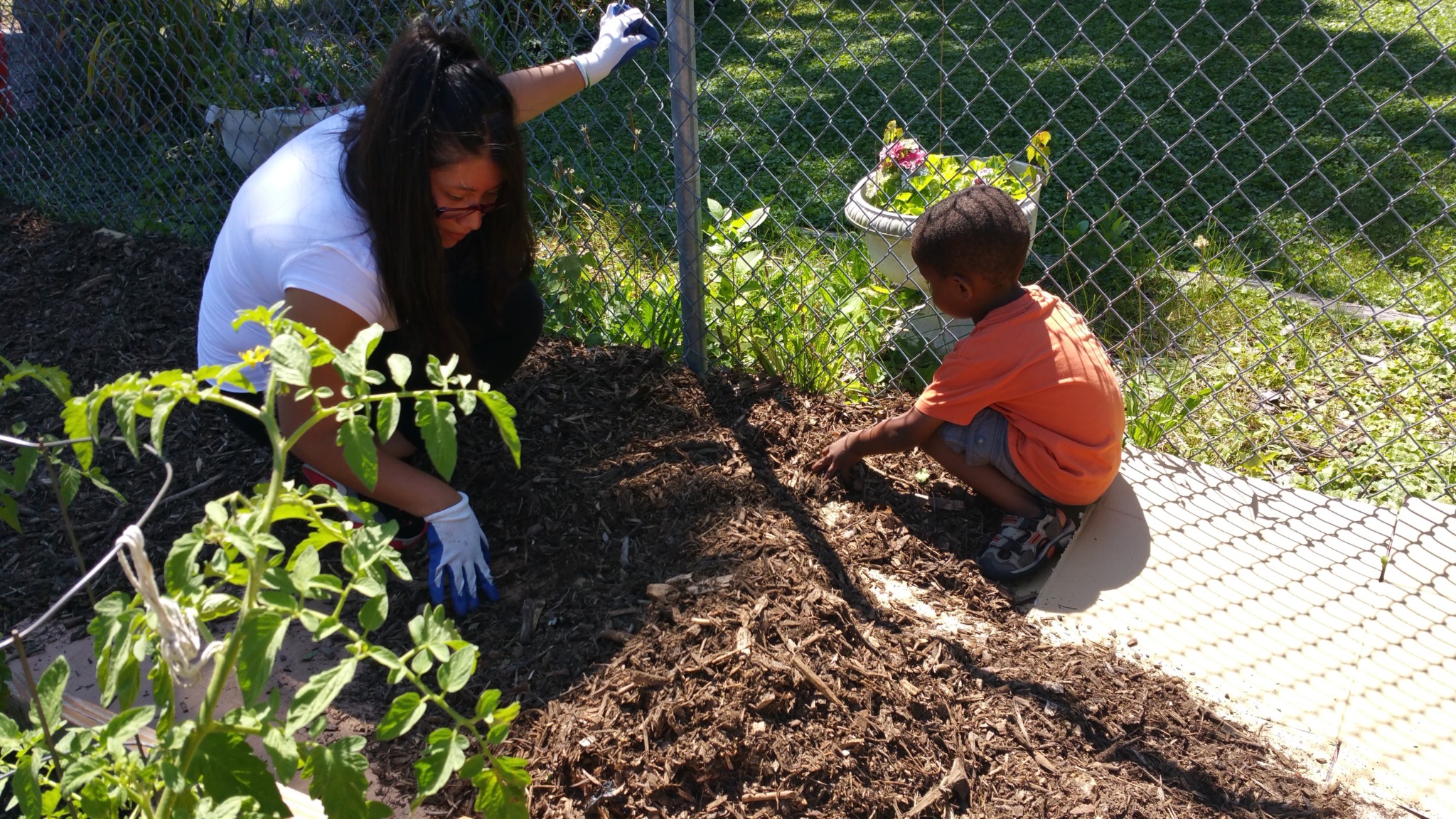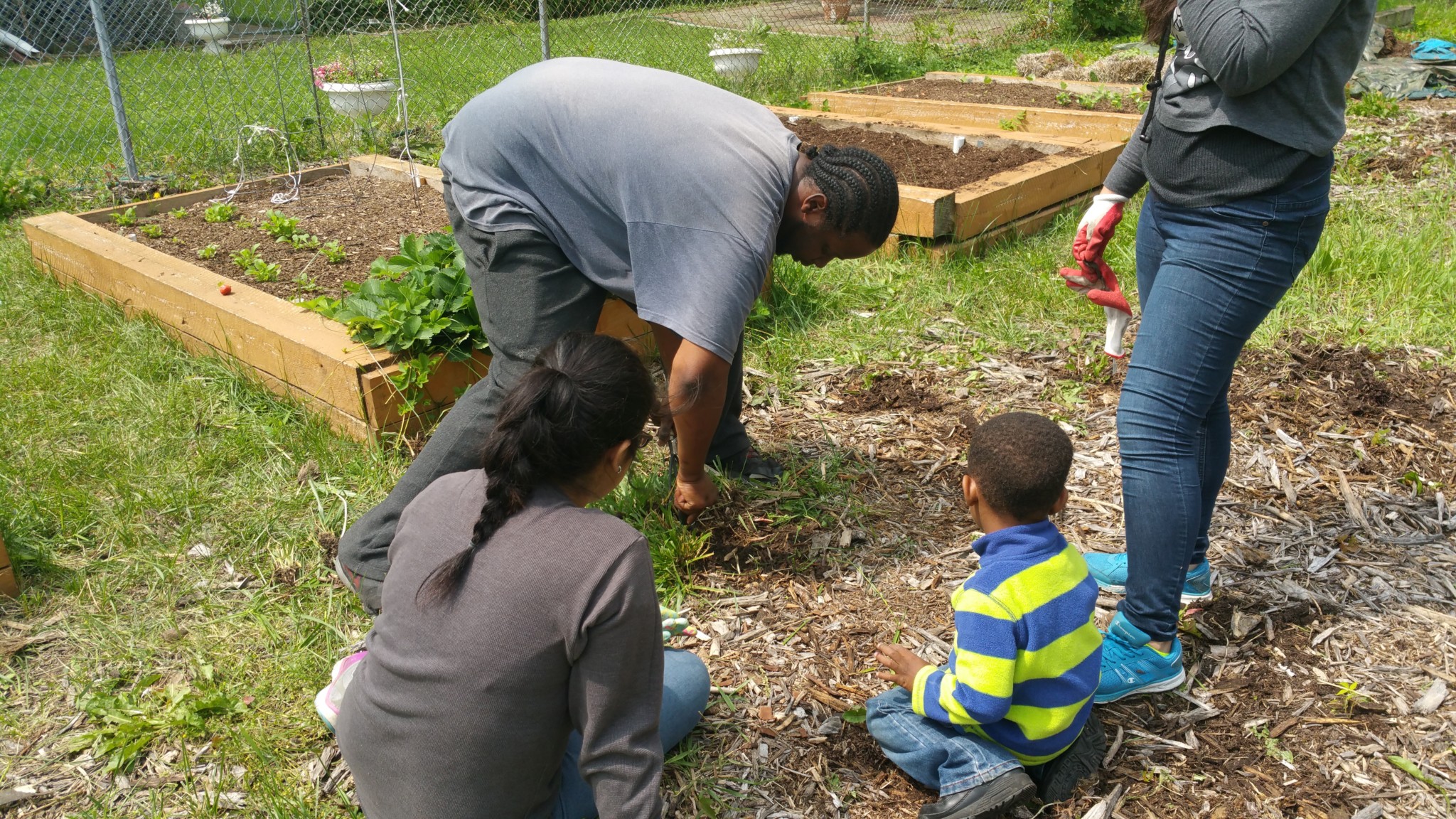How’s the community garden doing?” That’s a question that 6th District State Representative Sonya Harper asks in most of her meetings with the city of Chicago, just for good measure. The city’s response to Harper is usually that the garden is doing fine, and that nothing’s changed.
The garden she asks after is the Wood Street Meet and Greet Garden, which sits cozily between two homes on the 6100 block of South Wood Street, in West Englewood. Since 2012, when Harper and a few of her neighbors converted the vacant lot into a garden, the Wood Street garden has provided a dozen elevated garden beds for residents to grow tomatoes, chard, and several other vegetables, as well as a large open space with wooden benches for residents to convene at.
But last September, in a Department of Planning and Development meeting, the answer Harper heard was not what she expected at all. The garden, city officials said, was set to be sold along with 952 other vacant lots on the city’s South and Southwest Sides as part of the most recent round of the $1 Large Lots Program. The program, which launched in Englewood in 2014, is a city-run initiative that helps residents purchase vacant, city-owned land on their block for the price of one dollar.
The imminent sale of the garden stunned Harper and everyone who was involved with it. One of the qualifications to buy a Dollar Lot is to own and reside in property on the same block, which meant that whoever bought the lot that the Wood Street garden occupied would have to be someone who lived in the very neighborhood it served.
“We knew that nobody would try to buy the garden from under our nose,” Harper recalled when she first heard the news. The garden had been a source not only of jobs for the neighborhood—it was a site for the One Summer Chicago initiative that provided part-time jobs for youth at high risk of violence—but of fresh produce and a safe space for kids to play, which West Englewood lacks relative to other neighborhoods in the city.
The Department of Planning and Development (DPD) would not release any information about the Large Lot applicant to Harper at the time, citing that the information was not public until the sale was completed.
So Harper and other members of the garden took to the streets, knocking on doors to acquire signatures for a petition to save the garden. Over 400 people—basically everyone who lived within walking distance of the garden—signed the petition to show their support. They visited the alderman and mayor’s office, and even showed up at city council committee meetings.
It was only through the process of amassing signatures and talking to neighbors that Harper found out that the prospective buyer wasn’t a neighbor, but a landlord who owned a rental property on the block. With this information, Harper was able to get the city to block the sale. But major questions remained: how does a program designed to bring land back into the hands of neighborhood residents nearly approve the sale of a lot to someone who isn’t part of the neighborhood? And what does it take for the goal of community ownership to work out in practice?

The Dollar Large Lots pilot project began in Englewood in 2014, with 276 lots listed for sale. The idea behind the program was conceived during meetings between community organizations Resident Association of Greater Englewood (R.A.G.E.) and Teamwork Englewood, along with the Chicago Metropolitan Agency for Planning (CMAP), the Local Initiatives Support Corporation (LISC), and the city. The goal of these meetings was to gather community input for the Green Healthy Neighborhoods Plan, a ten-to-twenty-year planning strategy to maximize the use of vacant land and other resources for Englewood and surrounding neighborhoods. Members of R.A.G.E. submitted recommendations to CMAP for a program that would allow homeowners to purchase any vacant city-owned lot for below market rates to use as they wish.
Asiaha Butler, the president of R.A.G.E. who has contributed to the Weekly, said that a lot of community engagement in the form of monthly meetings, surveys, and forums went into the process of developing a pilot version of the Large Lots Program. “We were very conscious of the fact that we didn’t want developers to take advantage of [the program], and we didn’t want churches to take advantage of it either because they already get the lots donated to them,” said Butler. Their goals were simply to provide an avenue for homeowners to add additional value to their home, and to provide a means to address the problem of vacant and abandoned property in the neighborhood.
In Englewood, a history of disinvestment and residents moving elsewhere has contributed to a large stock of vacant lots and abandoned properties. The community area currently has the highest number of city-owned vacant properties in Chicago, with 1,619 vacant lots and West Englewood closely following with 1,088 vacant lots.
Nicole Johnson, data and communications manager at Teamwork Englewood, said that the 2008-2009 recession hit the Greater Englewood area particularly hard, with a significant number of residents being forced to leave their homes. What resulted were hundreds of what Johnson terms “zombie properties,” abandoned properties either sold to private investors, demolished and sold to the city, or foreclosed on.
Between 2005 and 2011, Englewood had the highest share of foreclosed two- to four-unit buildings in the city. Those that underwent foreclosure often never finished the process, resulting in properties with vacant and abandoned buildings. Many of the abandoned properties that the city purchased were ultimately demolished and converted to vacant lots.
One of the main goals outlined in the 2016 Englewood Quality of Life Plan II, written by Teamwork Englewood in collaboration with LISC and a few other organizations, included the goal of reducing vacant, unmaintained residential and commercial lots by thirty percent over the following five years.
The Large Lots Program has been perceived as a mutual win on this front for both the city and residents: through the program, residents have the opportunity to gain greater control over land in their neighborhood, and previously vacant lots are returned to the tax rolls. Since the Englewood pilot, the program has expanded to other South and Southwest Side neighborhoods including Auburn Gresham, Washington Park, Garfield Park, Gage Park, and several others. In Englewood, “people are very aware [of the program],” said Johnson, who gets a lot of calls and inquiries from residents interested in buying Dollar Lots.
“One of the residents purchased a lot and made it into an outdoor meeting space for dancing and music and just a nice little space as an extension of her home. So yeah, people have benefitted from [the program] immensely,” said Johnson. A number of grants, ranging from $1600 to $2500, made available by the Kresge Foundation and distributed by LISC and Teamwork Englewood, have been awarded to Large Lots owners to build community-oriented spaces like art walks and gardens.
“It’s not easy to get a lot if you apply, especially depending on where it is,” Johnson said. Although there are more than enough Large Lots available for sale compared to the number people qualified to buy them, not all of them are equally as popular. The application process can become competitive when multiple people want the same lot. In those cases, the city will host an in-person lottery to determine the chosen applicant. According to data obtained by the Weekly, as of September 2017, in Englewood and West Englewood there were at total of 511 applications, with 110 applications receiving approval.
Another obstacle the program faces is the low rate of homeownership in neighborhoods like Englewood, which means that only around thirty percent of residents would even qualify to buy a Large Lot. It is definitely a challenge that the program alone can’t solve, but Butler believes that Dollar Lots are a step in the right direction. “In Englewood,” she said, “we’re working really hard to make sure the current homeowners here find avenues to reclaim their land and neighborhood,” and to help them feel a sense of ownership and care about the land in their community.
The complications that arose with the case of the near sale of the Wood Street garden bring to light certain tensions around land ownership within the community.
Under the Large Lots Program, any city-owned, residentially-zoned vacant lot within participating community areas is eligible to be listed as a Dollar Lot. But the one person who would most have benefitted the garden by purchasing the lot through the Large Lot Program— Rep. Sonya Harper—was unable to, and the one person who should not have been eligible to purchase the lot—an absentee landlord—almost got away with it.
Last fall, upon learning that the garden was eligible for purchase through the Large Lot program, Harper considered purchasing it herself. But even though Harper cared for and paid taxes on two properties on the 6100 block of S. Wood Street, she was unable to purchase the lot because neither of the property titles was in her name.
The proposed buyer of the Wood Street garden, on the other hand, was a landlord who, according to Harper, was well known for being neglectful. In a neighborhood like Englewood, there are a lot of ghost, or absentee, landlords who Harper says “just buy land or property, and they either sit on them or don’t check on them very often.”
The Large Lot Program does have additional stipulations for landlords who own multiple properties on the block and want to buy a Dollar Lot but don’t live there themselves. “We definitely didn’t want investors just cashing in, so there was some other level of support that we needed, if you were just a landlord,” says Butler. “It was a discussion, outside of churches and nonprofits, the buyer should be a resident who lives there—that was the whole purpose of the program.”
Butler believes that Large Lot applications from landlords need a letter of support from the appropriate alderman indicating permission to purchase the Dollar Lot. (The DPD did not respond to multiple requests for confirmation, over phone and email, by publication.) Butler said that one landlord who owns several properties in Englewood was a good example of a landlord who might qualify for alderman permission: she had already been taking care of the vacant lots because they were next to the properties her tenants lived in.
The alderman functions as a final check before a lot is approved to be sold. After all applications to buy a lot listed as a Dollar Lot have been gathered, the DPD sends a list of these lots to the respective ward aldermen. Each alderman then reviews the lots and has the authority to delete properties from the list—they have the final word, as the DPD will not go above the alderman. Properties that the alderman does not delete are assumed to have their implicit support. The list then goes for a final review by City Council to pass an ordinance authorizing the bulk sale of the lots, a process that, from application to closing, can take anywhere from nine to twelve months.
In January, the Weekly filed a public records request with the Department of Planning and Development to view the status of the lot. It was found that as of January 20, the sale of Wood Street Meet and Greet Garden was denied and the garden is still in city hands—which Harper and members of the garden also only found out after the Weekly filed the request.
Although it was a relief for them to hear that the sale was denied, questions still remain about how exactly it was denied under the existing provisions of the Large Lots Program. Was it retroactively removed from the list of lots set for sale by an alderman, or was this one lot voted out of the list by City Council because of pressure from Harper and the community? Of the 275 applications in Englewood that have been denied, how were the reasons for the denial of the Wood Street sale different from the others? (The Weekly contacted the office of Fifteenth Ward Alderman Raymond Lopez multiple times for a statement but did not get a response by publication.)
In the case of Wood Street Meet and Greet Garden, there seemed to be a disconnect between the realities of Wood Street residents and those in City Hall. Harper, with a leg on both sides, happened to stand in a spot where she could identify the issue before it was too late. “If I was not state representative, I would not know that the garden was being sold until the moment it was gone,” said Harper.

Harper acknowledges that when they first started the garden, they were aware that they were on city-owned property. “What was a dumping site, we took and turned into something beautiful, but at the time we didn’t have rights to the land either.”
After a month of canvassing neighbors, garden members know that the odds of having another potential Dollar Lot buyer from their block are slim. But because the city still holds title to the land, there is still a possibility that the city could sell the land or list it for sale as a Dollar Lot again.
For now, as spring arrives and the growing season begins, the Wood Street Meet and Greet Garden will continue to serve the community. But Harper and the garden members are also actively looking out for the garden’s future. With the help of Grow Greater Englewood, a nonprofit that focuses on creating sustainable food economies that Harper formerly served as the director of, they are currently filling out applications for the garden to be purchased by community garden land trust NeighborSpace.
If the application goes through, NeighborSpace will purchase the lot from the City of Chicago, conduct a series of environmental tests of the land, and work with the garden leader to provide educational and organizational support and resources. “The day-to-day vision and stewardship of the garden is totally up to the neighborhood garden group, it’s totally neighborhood-driven,” said Ben Helphand, executive director at NeighborSpace. “We’re there to be behind the scenes and deal with bureaucratic needs so that community members can focus on gardening and community building.”
Becoming a NeighborSpace site would provide permanent protection against potential development, allowing the garden to grow and expand in the next two years, according to Anton Seals, executive director at Grow Greater Englewood. Helphand says that NeighborSpace focuses primarily on existing gardens that need to be protected from changing land ownership. It would also provide an institutional ownership structure for the garden, rather than having one member shoulder the financial burdens of maintaining the garden. If Harper or another member were to buy Wood Street Meet and Greet Garden as a Dollar Lot, they would be solely responsible for the tax burden, an issue NeighborSpace resolves on its own.
When the garden slipped through the cracks earlier last year and was set to be sold to a landlord as a Dollar Lot, how quickly neighbors rallied to do everything they could to save it was a clear sign of the potential for Wood Street Meet and Greet Garden to bring people together. “Our garden is kind of like our block club here on 6100 South Wood Street,” Harper said. “And if it has no other partnerships across the city or across the community, it just serves the purpose of keeping that community connected.”
“It’s very intergenerational,” Harper added. “That’s important for a community like this that is struggling to become a community again, so we can begin to learn to trust our neighbors and use our own collective powers to effect change when some of our leaders aren’t doing that work.”
Amy Qin is a contributing editor at the Weekly and a history major at the University of Chicago. She loves sunrises at Promontory Point and is always on the hunt for a good chicken and waffles. She last wrote for the Weekly about community building efforts in beloved South Side cafés in March.

